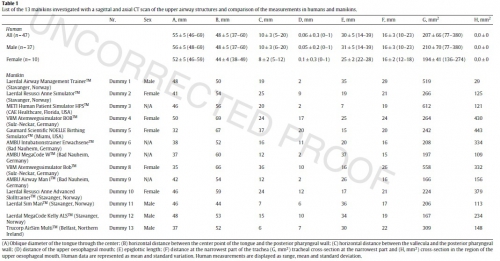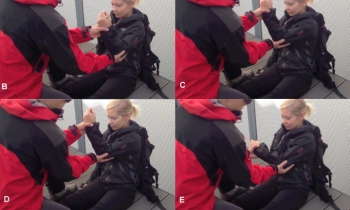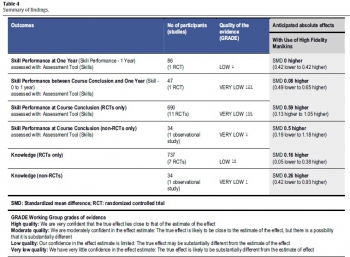21/05/2015
Simulateurs d'airway: Fiables ?
A radiographic comparison of human airway anatomy and airway manikins – Implications for manikin-based testing of artificial airways
Schalk R et Al. Resuscitation. 2015 May 11. pii: S0300-9572(15)00199-9
----------------------------------------------------------
La maîtrise des techniques de contrôle des voies aériennes est un des enjeux de la médecine préhospitalière militaire. Le recours à la simulation est devenu très fréquent. Pour autant ce travail montre que cette méthode d'apprentissage a ses limites. L'une d'entre elle est le fait que les simulateurs de tache ne reproduisent pas correctement l'anatomie des voies aériennes.
----------------------------------------------------------
Objective
The aim of this prospective, single-center, observational study was to investigate the accuracy of modeling and reproduction of human anatomical dimensions in manikins by comparing radiographic upper airway measurements of 13 different models with humans.
Methods
13 commonly used airway manikins (male or female anatomy based) and 47 controls (adult humans, 37 male, 10 female) were investigated using a mediosagittal and axial cervical spine CT scan. For anatomical comparison six human upper airway target structures, the following were measured: Oblique diameter of the tongue through the center, horizontal distance between the center point of the tongue and the posterior pharyngeal wall, horizontal distance between the vallecula and the posterior pharyngeal wall, distance of the upper oesophageal orifice length of epiglottis distance at the narrowest part of the trachea. Furthermore, the cross-section of the trachea in axial view and the cross-section of the upper oesophageal orifice in the same section was calculated. All measurements were compared gender specific, if the gender was non-specified with the whole sample.
Results
None of the included 13 different airway manikins matched anatomy in human controls ( n = 47) in all of the six measurements. The Laerdal Airway Management Trainer, however, replicated human airway anatomy at least satisfactorily.

Conclusion
This investigation showed that all of the examined manikins did not replicate human anatomy. Manikins should therefore be selected cautiously, depending on the type of airway securing procedure. Their widespread use as a replacement for in vivo trials in the field of airway management needs to be reconsidered.
| Tags : airway
Médecine de haute altitude: En pratique, c'est quoi ?
Mount Everest Base Camp Medical Clinic “Everest ER”: Epidemiology of Medical Events During the First 10 Years of Operation
Pressman BA et AL. Wilderness Environ Med. 2015 Mar;26(1):4-10
----------------------------------------------------------------------
Si l'intervention dans de telles conditions nécessite évidemment une pratique réelle de la montagne en haute altitude, la spécificité de la pathologie médicale rencontrée semble être essentiellement en rapport avec l'isolement.
----------------------------------------------------------------------
Objective:
As the highest peak on the planet, Mount Everest provides a truly austere environment in which to practice medicine. We examined records of all visits to the Everest Base Camp Medical Clinic (Everest ER) to characterize the medical problems that occur in these patients.
Methods:
A retrospective analysis of medical records from the first 10 years of operation (2003–2012) was performed. Descriptive data collected included patient demographics, diagnoses, treatments, prescriptions, medications dispensed, and evacuation type, if any.
Results: In all, 2941 patients were seen for a total of 3569 diagnoses. The number of patient visits each year at the Everest ER increased at a greater rate than the total numbers of climbers attempting Mount Everest over this period. The most commonly treated patients were Nepalese, accounting for 51% of all nationalities. The most common medical diagnoses were from pulmonary causes such as high altitude cough and upper respiratory infections, comprising more than 38% of all medical diagnoses. The most common traumatic diagnoses were from dermatologic causes such as frostbite and lacerations, comprising 56% of all traumatic diagnoses. Pulmonary and dermatologic diagnoses were also the most frequent reasons for evacuation from Everest Base Camp, most commonly for high altitude pulmonary edema and frostbite, respectively.
Conclusions:
Medical professionals treating patients at extreme altitude should have a broad scope of practice and should be well prepared to deal with serious traumas from falls, cold exposure injuries, and altitude illness.
| Tags : altitude
19/05/2015
Luxation d'épaule: Une méthode simple ?
Reduction of Acute Shoulder Dislocations in a Remote Environment: A Prospective Multicenter Observational Study
Bokor-Billmann T. et Al. Wilderness Environ Med. 2015 Mar 27. pii: S1080-6032(15)00006
OBJECTIVE:
Acute dislocations of the glenohumeral joint are common in wilderness activities. Emergent reduction should take place at the site of trauma to reduce the patient's pain and the risk of vascular and neurological complications. A limited number of reduction methods are applicable in remote areas. The aim of this study is to present our method of reduction of anterior shoulder luxation that is easily applicable in remote areas without medication, adjuncts, and assistants and is well tolerated by patients.
METHODS:
A prospective observational study was conducted during a 5-year period. The patients included underwent closed manual reduction with our technique. After each reduction, the physician who performed the reduction completed a standardized detailed history, and reexamined the patient (for acute complications). The patients were contacted 6 months after the trauma to investigate long-term postreduction complications.
Diagram depicting the steps of our reduction procedure. The practitioner holds the patient’s wrist with the left hand (in the case of a left shoulder dislocation) and the patient’s elbow with the right hand.

(B) With the elbow in 90° of flexion, the glenohumeral joint is flexed forward to 90°. (C) While still in flexion, the glenohumeral joint is adducted until the elbow reaches the midline of the body; it is important to continue this movement until this landmark is completely reached. (D) Then, internal rotation of the shoulder is performed. During this step, the patient’s elbow must stay at the landmark described above. At 25° to 30° of rotation, a mild resistance is usually encountered. (E) The last step of the maneuver consists of applying a constant internal rotation pressure to overcome this mild resistance without pain. Reduction is usually achieved at approximately 30° of internal rotation.
RESULTS:
Reduction was achieved with our method in 39 (100.0%) of 39 patients. The mean pain felt during our reduction procedure was rated 1.7 ± 1.4 (on a scale of 10) using the visual analog scale scoring system. No complications were noted before or after the reduction attempts. We did not find any long-term complications.
CONCLUSIONS:
The reduction method presented in the present study is an effective method for the reduction of acute shoulder luxations in remote places. Our data suggest that this method could be applied for safe and effective reduction of shoulder dislocation.
| Tags : réduction
07/05/2015
CICO: Stratégies et équipement
Equipment and strategies for emergency tracheal access in the adult patient
Hamaekers A; et All. Anaesthesia, 2011, 66 (Suppl. 2), pages 65–80
-----------------------------------------------------------------------
Un document qui passe en revue les équipements à mettre en oeuvre lors de sutuation de CICO (Can't intubate can't oxygneate)
-----------------------------------------------------------------------
The inability to maintain oxygenation by non-invasive means is one of the most pressing emergencies in anaesthesia and emergency care. To prevent hypoxic brain damage and death in a ‘cannot intubate, cannot oxygenate’ situation, emergency percutaneous airway access must be performed immediately. Even though this emergency is rare, every anaesthetist should be capable of performing an emergency percutaneous airway as the situation may arise unexpectedly. Clear knowledge of the anatomy and the insertion technique, and repeated skill training are essential to ensure completion of this procedure rapidly and successfully. Various techniques have been described for emergency oxygenation and several commercial emergency cricothyroidotomy sets are available. There is, however, no consensus on the best technique or device. As each has its limitations, it is recommended that all anaesthetists are skilled in more than one technique of emergency percutaneous airway. Avoiding delay in initiating rescue techniques is at least as important as choice of device in determining outcome
| Tags : coniotomie, intraosseux, airway
02/05/2015
Haute fidélité: Utile ? Pas si sûr
The use of high-fidelity manikins for advanced life support training. A systematic review and meta-analysis
Cheng A et All. Resuscitation. 2015 Apr 14. pii: S0300-9572(15)00152-5
---------------------------------------------------------
Le recours à la simulation apparaît incontournable en pédagogie médicale. L'emploi de mannequins haute fidélité connait un essort majeur. Si la satisfaction des étudiants semble au rendez-vous, il n'est cependant pas si évident que la simulation haute fidélité soit dimensionnante en terme d'acquisition réelle de savoir faire. Les avis sont partagés. Ainsi C'est travail évoque un niveau de preuve relativement faible voir absent. Compte tenu du coût non négligeable des mannequins haute fidélité, un tel investissement doit donc être réfléchi.
--------------------------------------------------------
Objectives:
The objective of this study was to evaluate the effectiveness of high versus low fidelity manikins in the context of advanced life support training for improving knowledge, skill performance at course conclusion, skill performance between course conclusion and one year, skill performance at one year,skill performance in actual resuscitations, and patient outcomes.
Methods:
A systematic search of Pubmed, Embase and Cochrane databases was conducted through January31, 2014. We included two-group non-randomized and randomized studies in any language comparing high versus low fidelity manikins for advanced life support training. Reviewers worked in duplicate to extract data on learners, study design, and outcomes. The GRADE (Grades of Recommendation, Assess-ment, Development and Evaluation) approach was used to evaluate the overall quality of evidence foreach outcome.
Results: 3840 papers were identified from the literature search of which 14 were included (13 randomized controlled trials; 1 non-randomized controlled trial). Meta-analysis of studies reporting skill performanceat course conclusion demonstrated a moderate benefit for high fidelity manikins when compared withlow fidelity manikins [Standardized Mean Difference 0.59; 95% CI 0.13–1.05]. Studies measuring skill performance at one year, skill performance between course conclusion and one year, and knowledge demonstrated no significant benefit for high fidelity manikins

Conclusion:
The use of high fidelity manikins for advanced life support training is associated with moderate benefits for improving skills performance at course conclusion. Future research should definethe optimal means of tailoring fidelity to enhance short and long term educational goals and clinical outcomes.
| Tags : simulateurs
01/05/2015
Medevac tactique:Médicalisation utile pour 30% des blessés
En-Route Care Capability From Point of Injury Impacts Mortality After Severe Wartime Injury
Morrison JJ et AL. Ann Surg 2013;257: 330–334
Il est difficile de se faire une idée de l'efficience de nos organisations de relève des blessés de guerre. En effet les 2/3 de ses derniers sont peu graves et ne nécessitent pas de pratiques avancées. Le conflit afghan a permis de confirmer la pertinence d'un certain nombre de faits: Une stratégie de conditionnement basé sur l'analyse des causes évitables de décès, l'importance de la mise en place d'un réseau structuré de prise en charge préhospitalière et hospitalière. Ce document confirme que la médicalisation avancée améliore la probabilité de survie des blessés de gravité intermédiaire qui représentent tout de même près du 1/3 des cas rencontrés et qui justifient nos organisations. Ceci confirme que la maîtrise de pratiques de base de réanimation préhospitalière devrait donc être l'un des piliers de l'organisation des évacuations médicales tactiques.
OBJECTIVE:
The objective of this study is to characterize modern point-of-injury (POI) en-route care platforms and to compare mortality among casualties evacuated with conventional military retrieval (CMR) methods to those evacuated with an advanced medical retrieval (AMR) capability.
BACKGROUND:
Following a decade of war in Afghanistan, the impact of en-route care capabilities from the POI on mortality is unknown.
METHODS:
Casualties evacuated from POI to one level III facility in Afghanistan (July 2008-March 2012) were identified from UK and US trauma registries. Groups comprised those evacuated by a medically qualified provider-led, AMR and those by a medic-led CMR capability. Outcomes were compared per incremental Injury Severity Score (ISS) bins.
RESULTS:
Most casualties (n = 1054; 61.2%) were in the low-ISS (1-15) bracket in which there was no difference in en-route care time or mortality between AMR and CMR. Casualties in the mid-ISS bracket (16-50) (n = 583; 33.4%) experienced the same median en-route care time (minutes) on AMR and CMR platforms [78 (58) vs 75 (93); P = 0.542] although those on AMR had shorter time to operation [110 (95) vs 117 (126); P < 0.001]. In this mid-ISS bracket, mortality was lower in the AMR than in the CMR group (12.2% vs 18.2%; P = 0.035). In the high-ISS category (51-75) (n = 75; 4.6%), time to operation was lower in the AMR than the CMR group (66 ± 77 vs 113 ± 122; P = 0.013) but there was no difference in mortality.
CONCLUSIONS:
This study characterizes en-route care capabilities from POI in modern combat. Conventional platforms are effective in most casualties with low injury severity. However, a definable injury severity exists for which evacuation with an AMR capability is associated with improved survival.
| Tags : evasan
Gelures
Cold Exposure Injuries to the Extremities
Golant A. et AL. J Am Acad Orthop Surg 2008;16:704- 715
-------------------------------------------------
Un document un peu ancien, mais bien fait notamment une physiopathologie clairement présentée.
-------------------------------------------------
Cold exposure injuries comprise nonfreezing injuries that include chilblain (aka pernio) and trench, or immersion, foot, as well as freezing injuries that affect core body tissues resulting in hypothermia of peripheral tissues, causing frostnip or frostbite. Frostbite, the most serious peripheral injury, results in tissue necrosis from direct cellular damage and indirect damage secondary to vasospasm and arterial thromboses. The risk of frostbite is influenced by host factors, particularly alcohol use and smoking, and environmental factors, including ambient temperature, duration of exposure, altitude, and wind speed. Rewarming for frostbite should not begin until definitive medical care can be provided to avoid repeated freeze-thaw cycles, as these cause additional tissue necrosis. Rewarming should be rapid and for an affected limb should be performed by submersion in warm water at 104° to 107.6°F (40° to 42°C) for 15 to 30 minutes. Débridement of necrotic tissues is generally delayed until there is a clear demarcation from viable tissues, a process that usually takes from 1 to 3 months from the time of initial exposure. Immediate escharotomy and/or fasciotomy is necessary when circulation is compromised. In addition to the acute injury, frostbite is associated with late sequelae that include altered vasomotor function, neuropathies, joint articular cartilage changes, and, in children, growth defects caused by epiphyseal plate damage.
| Tags : gelures
